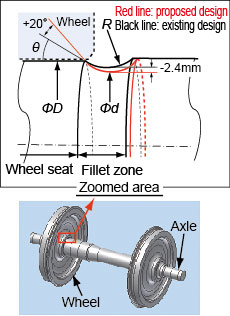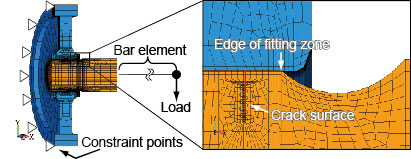3.Modified wheel/axle fitting surface design to improve fatigue strength
- A new design was proposed for the wheel/axle fitting zone in order to increase strength to fatigue.
- According to fatigue tests, stress analyses and crack propagation evaluations in fracture mechanics performed the proposed design offers demonstrably better fatigue strength.
Small cracks can develop in the contact area between a rail wheel and the axle as a result of fretting (repeated very small relative slip) due to deflection of the axle. It is therefore necessary to suppress fretting in order to improve fatigue strength. Consequently a quantitative assessment was performed to understand the relationship between the shape of the fitting surface and fatigue, and a proposal was made for a new design to demonstrably improve strength to fatigue.
First, stress analyses showed that when increasing the tangential angle θ between the wheel seat and the fillet and the radii ratio D /d (Fig. 1), stress on the fitting zone falls and fretting is clearly reduced. However, because of increasing stress on the fillet zone, initiation stress must be kept below the fatigue limit. Accordingly a proposal was made for a new design (red line in Fig.1) which would offer demonstrably better strength to fatigue by modifying the tangential angle and fillet radius as far as current vehicles would allow. The effectiveness of the proposed solution was verified in a fatigue test on a full size axle. The same test on the existing axle design produced a rupture-like crack, whereas on the new design only a negligible micro-crack was observed (Fig.2).
An analytical model reproducing a fatigue test on a full size axle was used to quantitatively assess safety improvement. Stress analysis was used to find the stress intensity factor for the crack initiation location which was then applied to evaluate crack propagation (Fig.3). Test results for the existing and new axle designs were compared, and validation was obtained that in the new design the stress intensity factor was lower by more than 15%, cracks did not growth easily and safety was improved.
The proposed news design should be able to enhance the safety of axles used on conventional lines, make it possible to maintain safety tolerances as dynamic loads increase with higher speeds and should contribute to making axles lighter.

Fig.1 Detail of the fitting surface
Fig.2 Magnetic particle inspection test results
Fig.3 Analytical model